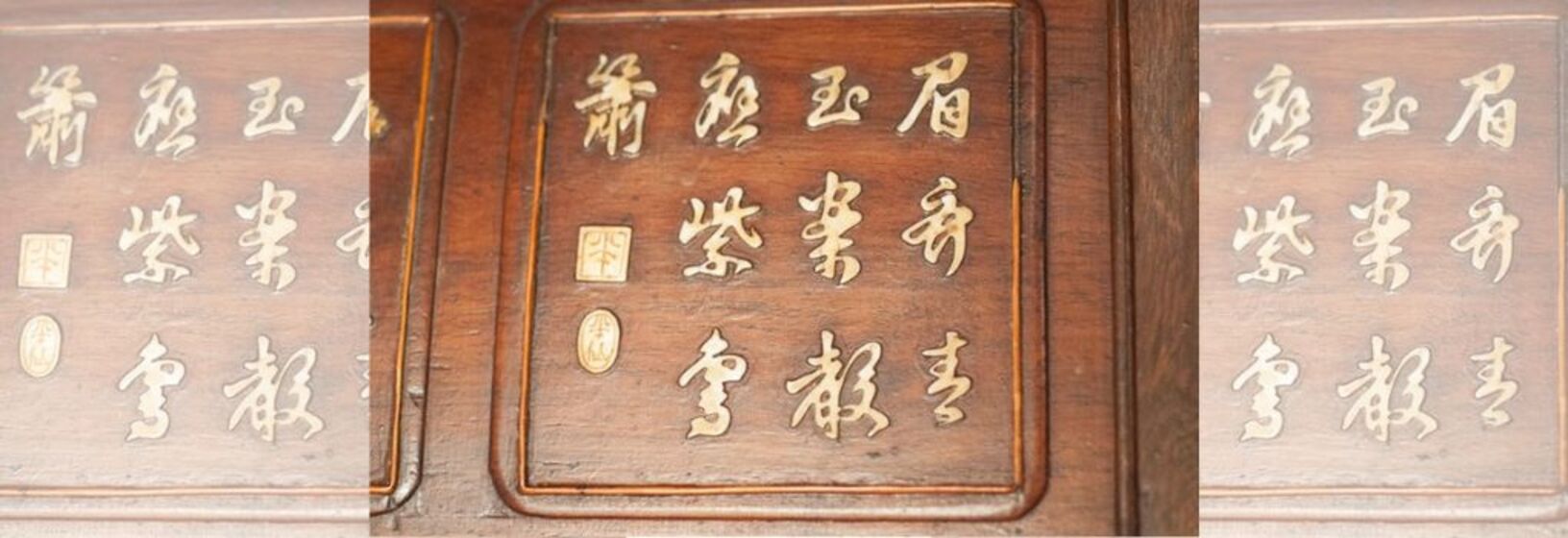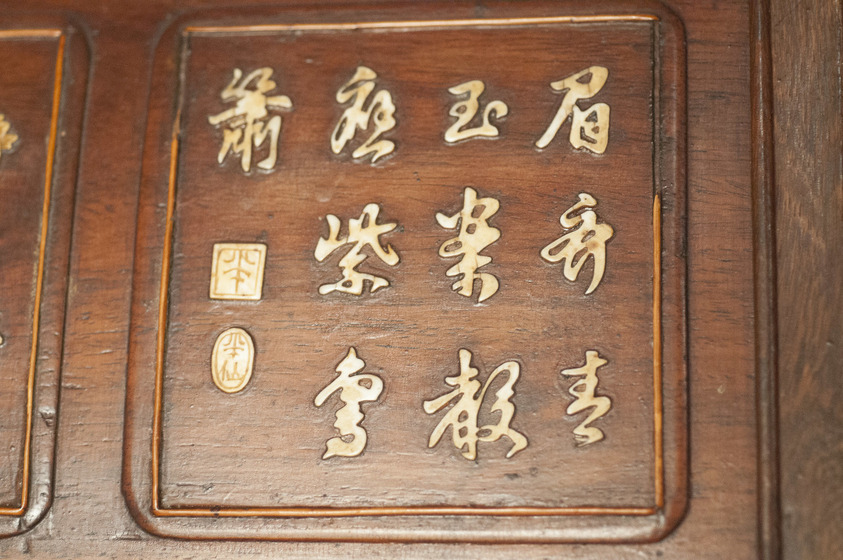A crude translation of the right-hand couplet is: “May brows meet on a blue-jade bed; and may voices harmonize to the notes of the phoenix panpipe”. These words are, however, rich in meaning and literary allusion.
The right hand couplet on the bed belongs to a type called 喜聯 (pronounced xǐlián in Mandarin and héilyùhn in Cantonese), which are felicitations, i.e. good wishes or celebratory phrases, in couplet form.
The first character in this couplet 眉 means “eyebrows” and contrasts with the first character of its second half 聲, which means “voices”. The second character 齊 is a verb that means “are level in height”, and the second character of the second line 應 means “correspond with”, “answer to” or “match”. The last three characters of the first line 青玉案 form a single word or expression, as do the last three of the second line. The literal sense of this expression is a table or bed of blue jade, as it is composed of characters that mean “blue”, “jade” and “bed or table”, in that order.
This expression first appeared in a poem believed to have been written in the year 137 C.E. by張衡 (pronounced Zhāng Héng in Mandarin and Jēung Hàhng in Cantonese). The poem refers to a small table made of a particular type of jade called “bluejade”. The table is used in the poem as a gift to repay one given to him and thus later developed a literary meaning of any gift given to repay another’s. The use of the expression on the bed might be a reference to the gift of the bed by the husband’s family to his new wife from her dowry. The term “bluejade table” referred to in Zhāng Héng’s poem also had a symbolic association with honour, benevolence and virtue.
While the last character of the expression 案 refers to a small table in the poem, it can also mean a tray, bench, large table, or a bed, which is how it is used in this context. This character and the first two in this line might be intended to make the reader think of the idiom 舉案齊眉, “to lift a tray level with one’s brows”, as they form three of its four characters. This idiom is associated with respect shown between husband and wife. It has its origin in the Han dynasty story of 梁鴻 (pronounced Liáng Hóng in Mandarin and Lèuhng Hùhng in Cantonese). Liáng is said to have been a poor but moral man (lauded by the common people for his good deeds and later hounded by an emperor over his writings), who chose an unattractive wife for her goodness of character. The 後漢書 “History of the Latter Han” describes how before meals, his wife would always face her husband and lift the dinner tray level to her brow as a sign of respect.
The first character 青of the expression 青玉 “bluejade” is an ancient word that has several meanings: its original sense appears to have been “blue”, but from just over two millennia ago it was used to mean “black”, and probably around the same time, or a little later, it also developed the sense of “green” or “light green” – the colour of foliage. Today, there are expressions in use which use this word all three senses – as blue, black and foliage green. So it also has associations with the meaning green as in 青草 “green grass”, 青山 “green hills”, 青菜 “leafy greens”, and 青苔 “moss”.
The first character in the expression “bluejade” also carries its alternate meaning of “green”, and the word “jade” in its extended sense of fine material. Understood in this way the expression is a noun that means green bamboo or wood, and could refer to the bed or a bamboo mat, which are still commonly used by many people in Southern China to sleep on during summer. This three-character expression thus also has the additional meaning of a bed covered with a bamboo mat or a bed of green bamboo or fine wood.
The three-character expression at the end of the couplet’s second line 紫鸞簫 can be translated literally as “purple phoenix panpipe”. This is not a Chinese phoenix (鳳凰) but a similar mythical bird with no standard English translation, dubbed the “false phoenix” for the sake of this translation.
The expression is a set contraction of 紫玉鸞簫 “purple-jade phoenix panpipe”, where “purple-jade” is an alternate name for 紫竹, “purple bamboo” in Chinese and black bamboo in English. One form of this bamboo is bright purple and was a prized material during the Tang dynasty for the making of pipes and flutes. The expression “phoenix panpipe” is an elegant name for the panpipe: it comes about because the 鸞 “false phoenix” is said to have had a call that hit perfectly all five notes on the ancient Chinese musical scale.
It should be noted that while the last character in the expression 簫 can mean either a panpipe or a musical pipe formed from a single tube, the expression 鸞簫 “phoenix panpipe” refers only to the panpipe. The second line of the couplet could therefore be translated as “and may voices harmonize to the notes of the purple panpipe”, but this would not convey the full depth of the expression “purple panpipe”, nor would it be adequately clear from this translation that the theme of voices being in tune and harmony is common to various classical phrases that are still used today to wish couples a harmonious marriage.
Thanks to Ely Finch for his translation and explanation of these bed couplets.



